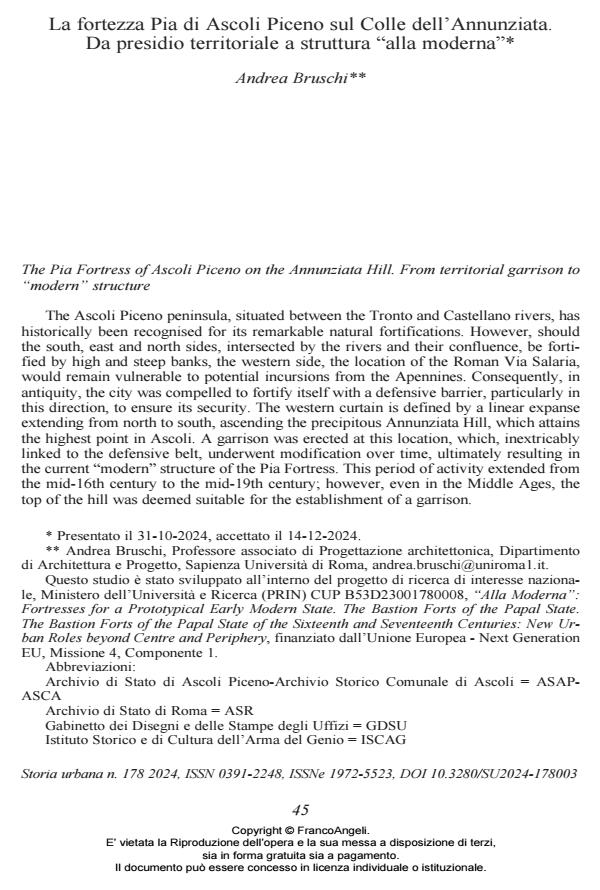The Pia Fortress of Ascoli Piceno on the Annunziata Hill. From territorial garrison to “modern” structure
Journal title STORIA URBANA
Author/s Andrea Bruschi
Publishing Year 2025 Issue 2024/178
Language Italian Pages 29 P. 45-73 File size 1882 KB
DOI 10.3280/SU2024-178003
DOI is like a bar code for intellectual property: to have more infomation
click here
Below, you can see the article first page
If you want to buy this article in PDF format, you can do it, following the instructions to buy download credits

FrancoAngeli is member of Publishers International Linking Association, Inc (PILA), a not-for-profit association which run the CrossRef service enabling links to and from online scholarly content.
The Ascoli Piceno peninsula, situated between the Tronto and Castellano rivers, has historically been recognised for its remarkable natural fortifications. However, should the south, east and north sides, intersected by the rivers and their confluence, be forti- fied by high and steep banks, the western side, the location of the Roman Via Salaria, would remain vulnerable to potential incursions from the Apennines. Consequently, in antiquity, the city was compelled to fortify itself with a defensive barrier, particularly in this direction, to ensure its security. The western curtain is defined by a linear expanse extending from north to south, ascending the precipitous Annunziata Hill, which attains the highest point in Ascoli. A garrison was erected at this location, which, inextricably linked to the defensive belt, underwent modification over time, ultimately resulting in the current “modern” structure of the Pia Fortress. This period of activity extended from the mid-16th century to the mid-19th century; however, even in the Middle Ages, the top of the hill was deemed suitable for the establishment of a garrison. The protracted construction of this strategic structure was therefore not solely an archi- tectural episode, but rather intersected on multiple occasions with the urban history. The Pia Fortress is indicative of the outcome of a prolonged overwriting process, and, in the final phase, exhibits anomalies, particularly with regard to the canons of the six- teenth-century treatises on the bastioned fortress. The present article investigates the main passages, focusing in particular on the “modern” configuration, a moment that changed the physiognomy of the walls and of the city of Ascoli itself.
Keywords: Ascoli Piceno, Pia Fortress, “Alla Moderna” fortress, City Wall, Military Architecture.
Andrea Bruschi, La fortezza Pia di Ascoli Piceno sul Colle dell’Annunziata. Da presidio territoriale a struttura “alla moderna” in "STORIA URBANA " 178/2024, pp 45-73, DOI: 10.3280/SU2024-178003